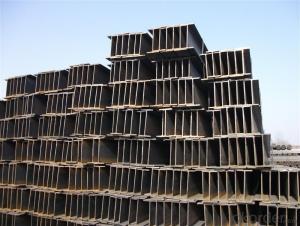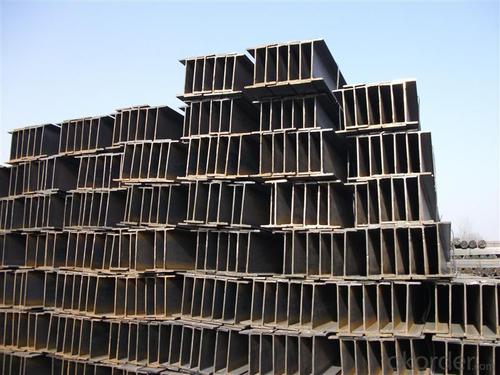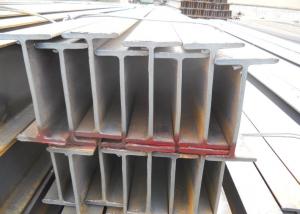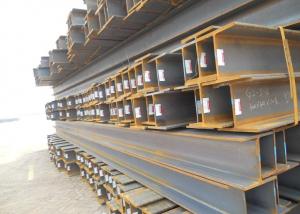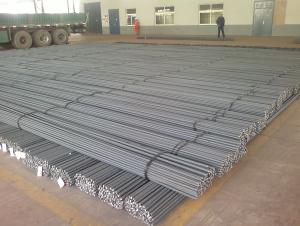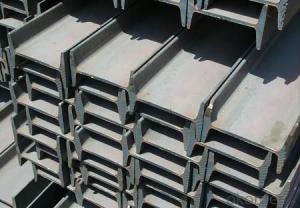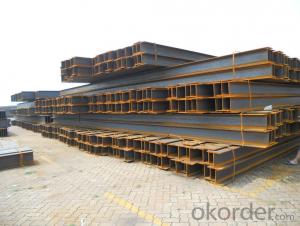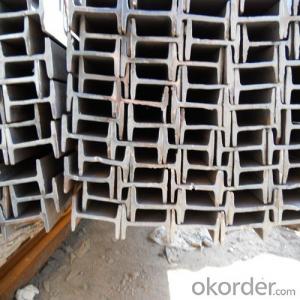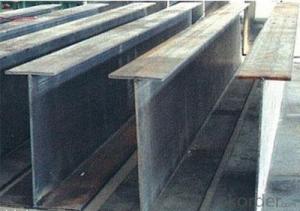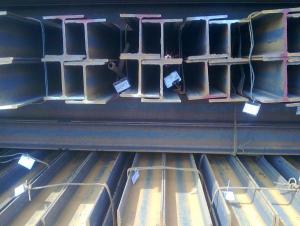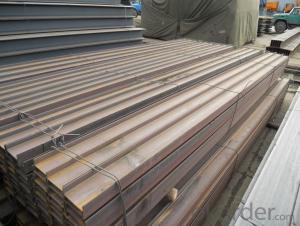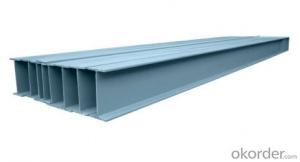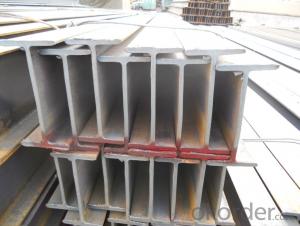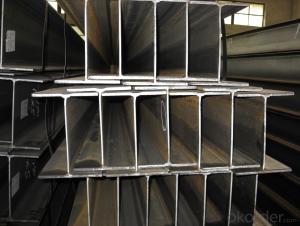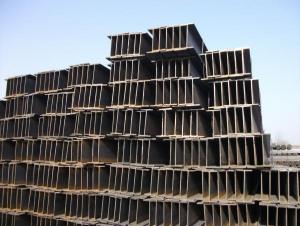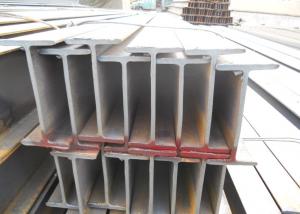Hot rolled steel H beams for sale
- Loading Port:
- Shanghai
- Payment Terms:
- TT OR LC
- Min Order Qty:
- 25 m.t.
- Supply Capability:
- 30000 m.t./month
OKorder Service Pledge
OKorder Financial Service
You Might Also Like
Specifications of Hot Rolled Structural Steel H Beam
1. Standard: GB700-88, Q235B2.
2. Grade: Q235, SS400 or Equivalent
3. Length: 6m,10m, 12m as following table
4. Invoicing on theoretical weight or actual weight as customer request
5.Payment: TT or L/C
6. Sizes:
SIZE(mm) | DIMENSION(kg/m) |
100*100 | 16.9 |
125*125 | 23.6 |
150*75 | 14 |
150*150 | 31.1 |
148*100 | 20.7 |
198*99 | 17.8 |
200*100 | 20.9 |
248*124 | 25.1 |
250*125 | 29 |
Usage & Applications of Hot Rolled Structural Steel H Beam
Commercial building structure ;Pre-engineered buildings; Machinery support structure; Prefabricated structure; Medium scale bridges; Ship-building structure. etc.
Packaging & Delivery of Hot Rolled Structural Steel H Beam
1. Packing: it is nude packed in bundles by steel wire rod
2. Bundle weight: not more than 3.5MT for bulk vessel; less than 3 MT for container load
3. Marks:
Color marking: There will be color marking on both end of the bundle for the cargo delivered by bulk vessel. That makes it easily to distinguish at the destination port.
Tag mark: there will be tag mark tied up on the bundles. The information usually including supplier logo and name, product name, made in China, shipping marks and other information request by the customer.
If loading by container the marking is not needed, but we will prepare it as customer request.
4. Transportation: the goods are delivered by truck from mill to loading port, the maximum quantity can be loaded is around 40MTs by each truck. If the order quantity cannot reach the full truck loaded, the transportation cost per ton will be little higher than full load.
5. Delivered by container or bulk vessel
Production flow of Hot Rolled Structural Steel H Beam
Material prepare (billet) —heat up—rough rolling—precision rolling—cooling—packing—storage and transportation
- Q: What are the typical spans and spacing for steel H-beams in roof structures?
- The typical spans and spacing for steel H-beams in roof structures vary depending on the specific design requirements and load calculations. However, in general, the spans for steel H-beams in roof structures can range from 15 to 60 feet, with spacing between beams typically ranging from 5 to 20 feet. It is crucial to consult with a structural engineer or a professional in the field to determine the most appropriate spans and spacing for a specific roof structure.
- Q: What are the different joining techniques used for connecting steel H-beams?
- There are several different joining techniques that can be used to connect steel H-beams. These techniques are used to ensure that the beams are securely connected and can withstand the loads and forces that they will be subjected to. Some of the common joining techniques for steel H-beams include: 1. Welding: This is one of the most common and widely used methods for joining steel H-beams. Welding involves melting the edges of the beams and fusing them together using heat. It provides a strong and permanent connection, but it requires skilled labor and proper welding techniques to ensure the quality and integrity of the joint. 2. Bolting: Another commonly used method for joining steel H-beams is through bolting. This involves using bolts, nuts, and washers to connect the beams together. Bolting provides a strong and durable connection, and it allows for easy disassembly and reassembly if needed. It is also less time-consuming compared to welding. 3. Riveting: Riveting is an older technique that involves using metal pins or rivets to connect the steel H-beams. This method requires drilling holes in the beams and inserting the rivets, which are then hammered or compressed to secure the joint. Riveting provides a strong connection, but it is less commonly used nowadays due to the availability of more efficient joining techniques. 4. Adhesive bonding: Adhesive bonding involves using high-strength adhesives or epoxy resins to bond the steel H-beams together. This method provides a lightweight and flexible connection, but it may not be suitable for applications that require high load-bearing capacity or where temperature variations are significant. 5. Mechanical connectors: Mechanical connectors, such as beam clamps or angle brackets, can also be used to join steel H-beams. These connectors are designed to provide a quick and easy connection, often without the need for welding or drilling. They are commonly used in construction projects where time and efficiency are crucial. It is important to note that the choice of joining technique depends on several factors, including the structural requirements, load-bearing capacity, project specifications, and budget. Consulting with a structural engineer or a qualified professional is recommended to determine the most suitable joining technique for connecting steel H-beams in a specific application.
- Q: Are steel H-beams fire-resistant?
- Steel H-beams are generally considered to be fire-resistant. This is because steel is a non-combustible material that does not burn or contribute to the spread of fire. In addition, steel has a high melting point, making it more resistant to heat and fire. However, it is important to note that while the steel beams themselves may be fire-resistant, other components of the building or structure, such as the connections or the surrounding materials, may not be. Therefore, it is crucial to consider the overall fire safety measures and building codes in place to ensure the overall fire resistance of a structure.
- Q: Are steel H-beams resistant to termites or other pests?
- Steel H-beams possess a remarkable resistance against termites and other pests. Unlike wooden beams, steel does not serve as a food source for these pests, thus making it a superb selection for structural components in buildings. Steel beams lack any nutritional value or cellulose content that would attract pests, guaranteeing their immunity to termite infestations or other issues related to pests. Moreover, steel is also impervious to rotting, warping, and decay, ensuring the longevity and durability of the structure. Consequently, steel H-beams emerge as a dependable and pest-resistant alternative for construction ventures.
- Q: Can steel H-beams be used for supporting agricultural structures?
- Yes, steel H-beams can be used for supporting agricultural structures. They are commonly used in construction due to their strength, durability, and ability to handle heavy loads. Steel H-beams provide stability and structural support, making them suitable for various agricultural applications such as barns, sheds, and greenhouses.
- Q: What's the quota for finished H - shaped steel sleeve?
- This question is really not easy to answer, the previous set of quotas also encountered this problem
- Q: What are the different types of steel H-beam connections used in airport terminals?
- There are several different types of steel H-beam connections commonly used in airport terminals. These connections are designed to provide structural support and stability to the terminal building. 1. Welded Connections: Welded connections are one of the most common types of steel H-beam connections used in airport terminals. In this type of connection, the H-beams are joined together using welding techniques such as arc welding or gas welding. Welded connections provide a strong and durable connection, ensuring the structural integrity of the terminal building. 2. Bolted Connections: Bolted connections involve using bolts and nuts to secure the H-beams together. This type of connection is often used in situations where the H-beams need to be easily disassembled or replaced. Bolted connections provide flexibility and ease of maintenance, as well as the ability to adjust the connection if necessary. 3. Moment Connections: Moment connections are designed to resist bending moments in the H-beams caused by external forces such as wind or seismic loads. These connections are typically more complex and involve additional components such as plates and stiffeners. Moment connections provide increased rigidity and strength to the terminal structure, ensuring its stability and safety. 4. Shear Connections: Shear connections are used to resist horizontal forces on the H-beams, such as those caused by wind or seismic activity. These connections are designed to transfer the shear forces between the beams and the supporting structure. Shear connections may involve the use of gusset plates, bolts, or welding techniques to ensure proper load transfer and structural stability. 5. Composite Connections: Composite connections involve combining steel H-beams with other materials such as concrete or timber to create a stronger and more efficient connection. This type of connection is often used in situations where additional strength or load-bearing capacity is required. Composite connections can provide enhanced structural performance and versatility in airport terminal construction. Overall, the choice of steel H-beam connections used in airport terminals depends on various factors such as the design requirements, structural loads, and construction methods. The selection of the appropriate connection type is crucial to ensure the safety, durability, and efficiency of the terminal building.
- Q: How do steel H-beams contribute to the structural integrity of buildings?
- Steel H-beams contribute to the structural integrity of buildings by providing superior strength, rigidity, and load-bearing capacity. Due to their shape, H-beams distribute weight evenly, allowing for efficient transfer of loads to the foundation. This ensures the building can withstand heavy loads, such as those from multiple floors, roofs, or equipment, without compromising its stability. Additionally, steel H-beams offer versatility and can be easily fabricated to meet specific structural requirements, making them an ideal choice for constructing safe and durable buildings.
- Q: Can steel H-beams be used in architectural design elements?
- Indeed, architectural design elements can make excellent use of steel H-beams. Due to their strength and durability, steel H-beams are widely favored in the construction industry. They serve as reliable structural supports in various large-scale projects, including buildings and bridges. However, their versatility extends beyond mere support, as they can also contribute to the creation of distinctive and visually captivating structures. Architects can incorporate steel H-beams in diverse ways, such as exposed beams, columns, or even decorative elements. The sleek and contemporary appearance of these beams can infuse architectural designs with an industrial or modern aesthetic. Moreover, their ability to bear heavy loads and span considerable distances makes them ideal for crafting open and spacious interior spaces. All in all, steel H-beams provide architects with a practical and adaptable solution for integrating structural elements into their designs, while simultaneously introducing a unique visual allure.
- Q: How do steel H-beams perform in coastal or saltwater environments?
- Steel H-beams perform reasonably well in coastal or saltwater environments, but they require proper maintenance and protective measures to prevent corrosion. The presence of saltwater and high humidity in coastal areas creates a corrosive environment that can accelerate the deterioration of steel. However, steel H-beams are commonly used in coastal construction projects due to their strength, durability, and cost-effectiveness. To ensure their performance and longevity in such environments, several considerations need to be taken into account. Firstly, the use of corrosion-resistant coatings is essential. Applying coatings such as epoxy, zinc, or galvanization can significantly enhance the steel's resistance to saltwater corrosion. These coatings act as a barrier between the steel and the corrosive environment, preventing direct contact and inhibiting the oxidation process. Regular inspections and maintenance are also crucial in coastal or saltwater areas. Inspecting the H-beams for any signs of corrosion, such as rust or pitting, is necessary to identify and address any early stages of deterioration. Any damaged or compromised protective coatings should be repaired or replaced promptly to prevent further corrosion. Furthermore, proper drainage and ventilation systems need to be in place to minimize the accumulation of saltwater and moisture on the steel surfaces. Excessive moisture or prolonged exposure to saltwater can speed up the corrosion process, leading to structural integrity issues. Adequate ventilation allows for the circulation of air, reducing the chances of moisture buildup and providing a more favorable environment for the steel. It is important to note that the performance of steel H-beams in coastal or saltwater environments also depends on the specific grade and quality of steel used. Choosing high-quality corrosion-resistant steel, such as stainless steel or weathering steel, can provide enhanced protection against saltwater corrosion. In conclusion, while steel H-beams can perform well in coastal or saltwater environments, it is crucial to implement proper maintenance and protective measures. Utilizing corrosion-resistant coatings, conducting regular inspections, ensuring proper drainage and ventilation, and selecting high-quality steel can all contribute to their long-term performance and durability in such challenging environments.
Send your message to us
Hot rolled steel H beams for sale
- Loading Port:
- Shanghai
- Payment Terms:
- TT OR LC
- Min Order Qty:
- 25 m.t.
- Supply Capability:
- 30000 m.t./month
OKorder Service Pledge
OKorder Financial Service
Similar products
Hot products
Hot Searches
Related keywords
